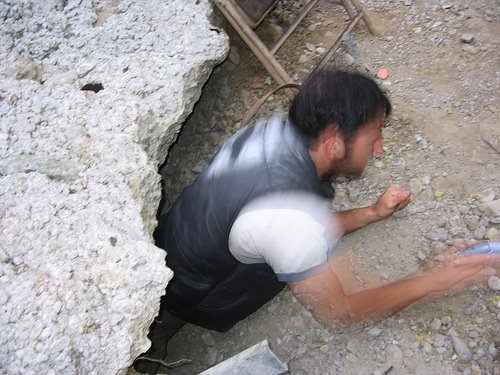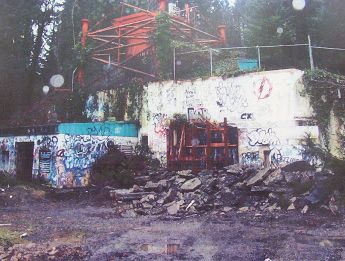About
Kelly Butte is a long-extinct volcanic cinder cone outside Portland, Oregon that’s presently used as a city park. But for a time, Kelly Butte was also the site of a two-story subterranean civil defense shelter designed to protect against Soviet atomic bombs. The 20,000-square-foot concrete box could shelter 250 local government employees and microfilm backups of three million city documents, including city council minutes going back to 1851.
The $670,000 Kelly Butte Civil Defense Shelter was authorized by Portland voters in 1952 and opened to great fanfare in 1956. Doomsday planning was hot after the Soviet Union acquired the hydrogen bomb and Portland’s civil defense director, Jack Lowe, was determined to “go first class or not at all.” The resulting bunker had stations set up for every branch of local government, heads of utilities, hospitals, and a military liaison. Thirty feet beneath the butte, the cave dwellers were protected by reinforced concrete laid on a shock absorbing base. Lowe estimated it could withstand a 20-kiloton explosion.
Portland saw itself as a model to replicate across the country. The city approached its grim task with praiseworthy earnestness. Mock evacuations were conducted and procedures were refined. The city council established continuity of government designees—basically a local government's version of Washington, D.C.’s line of Presidential succession. CBS even filmed a television documentary of the spectacle, titled A Day Called X.
But the first real test for the city’s emergency responders missed the mark and soured public opinion on Portland’s civil defense initiative. On Columbus Day in 1962, a terrible wind storm blew through the area and residents got a look at how their leaders responded in the face of a real-world disaster. According to Salem’s Capitol Journal, the city government, “seemingly ignored Kelly Butte’s undamaged shelters, took up headquarters in the basement of city hall, and were soon knocked out of contact with the rest of the city’s agencies when the radio antenna was damaged by winds. By then it was too late and the city was in chaos.”
Then the Cuban Missile Crisis kicked off just two weeks later, as President Kennedy announced unmistakeable evidence that, “a series of offensive missiles [are] now in preparation on that imprisoned island.” By this time many Americans believed any war involving nuclear weapons would likely lead to sudden annihilation, and urban evacuation plans increasingly looked like make-believe. In November 1962 a tax vote for Portland Civil Defense expenditures failed, which effectively ended the program and led to the shuttering of the Kelly Butte bunker.
From 1974 to 1994 Portland used the Kelly Butte bunker as a site for police dispatches and as a 911 call center. The underground shelter made for a bleak workplace and employees complained of “sick building syndrome.” After the city government finally moved out the Kelly Butte bunker, it sat abandoned and became an inviting target for mischief seekers. Local historian Jeff Felker created a blog to document the chaos that ensued as vandals and drug users slowly moved in, stripped copper wiring from the walls, set cooking fires, defecated in corners, and utterly ruined the dugout.
The city sealed the Kelly Butte bunker in 2006 and bulldozers piled heaps of earth over the entrance to ward off any raiders. Today, all that’s left to be seen is the very top of the concrete bunker that pokes out of the landfill.
Related Tags
Community Contributors
Added By
Published
August 21, 2017
Sources
- http://kellybuttebunker.blogspot.com/
- Raven Rock, by Garrett M. Graff
- http://www.wweek.com/outdoors/2016/06/14/what-lies-beneath-an-east-portland-butte/
- https://oregonencyclopedia.org/articles/kelly_butte_civil_defense_center_and_kelly_butte_natural_area/#.WZJLW3eGN9M
- https://warisboring.com/how-a-hipster-city-planned-to-survive-nuclear-armageddon/
- President declares cuba on offensive, Chicago Tribune, Oct. 23, 1962
























































